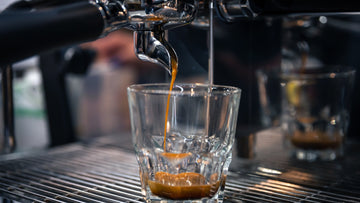If you’ve spent some time exploring espresso, you’ve probably heard about the 1:2 ratio — often praised as the golden ratio for espresso brewing. This simple number pops up so frequently in coffee discussions that many home brewers assume it’s the “only” correct way to pull a shot. But why has this particular measurement earned its reputation as coffee's golden ratio? And is it really the only ratio worth using? Let’s find out.
What Exactly is the 1:2 Coffee Ratio?
In espresso, the brew ratio compares the weight of dry coffee grounds to the weight of liquid coffee in your cup:
- 1 = the weight of dry coffee grounds
- 2 = the weight of liquid espresso extracted
For example:
- 18g of ground coffee → 36g of liquid espresso
- 20g of ground coffee → 40g of liquid espresso
This ratio forms the foundation for what professionals consider a balanced, full-flavored espresso shot.
Why 1:2 Became the “Golden Ratio”
While you can brew espresso at other ratios (1:1.5, 1:3, even 1:4), the 1:2 proportion has earned its reputation for a few key reasons:
1. High Enough Concentration
The brew ratio directly impacts coffee strength (concentration). With all other factors equal:
- More water → more yield but lower concentration
- Less water → less yield but higher concentration
In a controlled test using the same beans and a 30-second extraction:
- 1:2 (18 g in → 36 g out) = ~10.83% strength
- 1:4 (18 g in → 72 g out) = ~5.36% strength
Both had similar flavor notes (nutty, chocolatey), but the 1:2 shot tasted more intense and focused, while the 1:4 shot was lighter, with more distinct layers of flavor.
2. Perfect for Milk-Based Drinks
Most espresso isn’t consumed straight — it’s the base for drinks like lattes, cappuccinos, flat whites, and even “dirty” coffee. Milk naturally softens intensity, so starting with a concentrated shot ensures your drink remains rich and full-bodied.
3. Balanced Extraction
Coffee is only ~30% soluble in water. A 1:2 ratio generally hits the 18–22% extraction yield sweet spot where:
- Acids extract first (too low = sour)
- Sweetness peaks (ideal balance)
- Bitterness comes last (too high = harsh)
4. Consistency Across Beans & Machines
From Italian tradition to modern specialty cafés, 1:2 works well across different espresso blends and roasts, making it a reliable starting point whether you brew at home or commercially.
When You Don’t Have to Use 1:2
1:2 is a guideline, not a law. You might choose:
- Ristretto (1:1 to 1:1.5): More concentrated, syrupy, and bold.
- Lungo (1:2.5 to 1:4): More diluted, lighter body, and pronounced clarity.
- Slight tweaks like 1:1.8 or 1:2.3 can fine-tune flavor balance.
How to Brew Espresso at a 1:2 Ratio
Equipment Needed:
Scale (0.1g precision)
Timer
Grinder with fine adjustment
Brew Steps:
1. Weigh your coffee dose — Start with 15–20 g of fresh grounds.
2. Multiply by two — This is your target yield in grams.
Example: 18 g in → 36 g out
3. Distribute evenly in portafilter
4. Tamp with 15-20kg pressure
5. Start timer with pump
6. Stop at 36g output (25-30 seconds)
7. Adjust grind if extraction time is off
8. Taste and tweak
Sour? → Finer grind/extract longer
Bitter? → Coarser grind/reduce time
Final Thoughts
The 1:2 brew ratio has earned its golden reputation because it delivers a cup with balanced flavor and consistent results across different beans and machines.
It’s not the only way to make espresso — but it’s the most dependable starting point for both home baristas and professionals. From there, you can experiment and discover your personal sweet spot.






